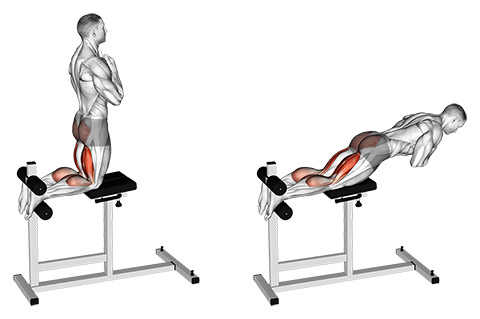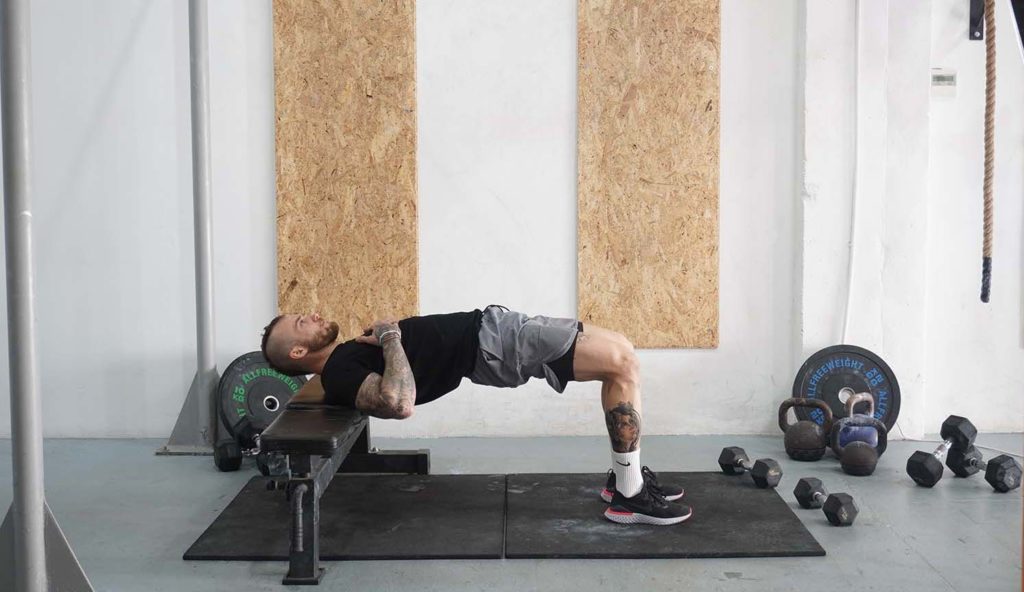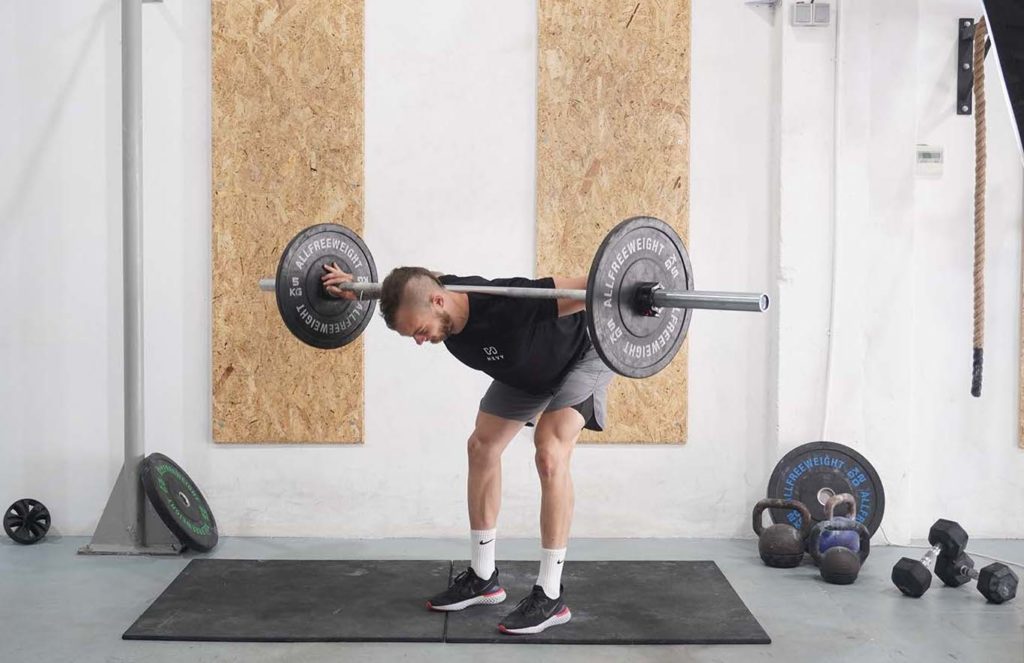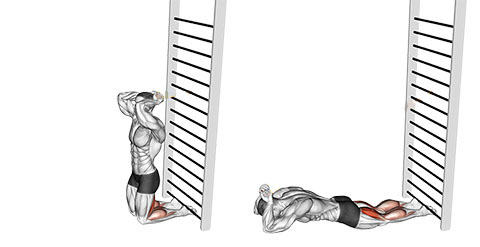Purpose of the Glute Ham Raises
Most people focus on squats and the quadriceps muscle group when thinking about lower body training. But one-sided exercise carries some drawbacks leading to issues down the road. Most notably, an imbalance between our front and rear muscles can hinder our performance, impact movement patterns, and put us at risk of injuries.
The glute ham raise is an effective compound movement that trains and strengthens our posterior chain. As a result, we reduce the risk of muscle imbalances and improve our training performance for optimal gym progress.
Doing glute ham raises is also beneficial for everyday life because the exercise strengthens crucial muscles, which we use for many activities. For example, bending forward to pick something off the floor requires good posterior chain activation. Glute hams also strengthen the lower back, providing spinal support and protecting us from injuries.
Tweak the glute ham raise machine until it fits you best. Specifically, the ankle pad should be right against your Achilles heel, and your knees should be on the front platform that will support your hips. If the machine has a foot platform, you should position both balls of the feet to push against it for extra support.
How to do the movement
Step by step Instruction:
- Tweak the glute ham raise machine until it fits you best. Specifically, the ankle pad should be right against your Achilles heel, and your knees should be on the front platform that will support your hips. If the machine has a foot platform, you should position both balls of the feet to push against it for extra support.
- With your torso upright, knees planted firmly, and ankles in a secure position, cross your arms in front of you, bring your shoulders back, and take a deep breath.
- From this position, go down as you simultaneously extend your knees and keep your back in a neutral position, and your hips should also remain in a rigid position.
- Go down as comfortably as you can – ideally until your knees are locked out, and exhale.
- Engage your posterior chain muscles and bring your torso back upright. You can think of this as a bodyweight curl that initiates from your back thigh muscles.
- Take another breath and bend forward again.
What muscles do the glute ham raises activate?
The primary muscle group involved in glute ham raises the hamstrings (1). This muscle consists of three heads: the biceps femoris, semitendinosus, and semimembranosus. The three heads originate from the lower pelvis, cover our rear thighs, and insert into the tibia bone, just below the knee (2). Our hamstrings play an important role in knee flexion and hip extension, which means they produce most of the force we need to move our torso up and down.

Our buttocks consist of three muscles like the hamstrings: the gluteus maximus, gluteus medius, and gluteus minimus. Glute ham raises do a great job of training all buttock muscles because they contract isometrically to keep us in position. Our glutes are also highly active during glute ham raises.
Glute ham raises also train one part of our calves. The gastrocnemius is the large superficial calf muscle that originates from the femur, just above the knee. The muscle group inserts into the ankle, where it produces plantar flexion. But because the muscle group crosses the knee joint, it also contributes to knee flexion, which means it assists our hamstrings during glute ham raises (3).
Aside from the lower body musculature, glute ham raises also train our back muscles. Specifically, the exercise trains our erector spinae, which straightens the back and keeps us upright. Our latissimus dorsi, rhomboids, and trapezius also activate to some degree, aiding the erectors in keeping the back straight.
Our abs, transverse abdominis, and obliques also contribute to some degree. Like our back muscles, the abdominals contract isometrically and support the torso as we move up and down.
Tips on Proper Form and Technique
A helpful tip to keep in mind for proper glute ham raises is to imagine that you’re curling your upper body through your hamstrings. In doing so, you can establish a better mind-muscle connection with your hamstrings.
When doing a glute ham raise, you should emphasize the lowering portion of each repetition. Doing so is vital for two reasons. First, you reduce the risk of pulling a muscle or injuring your knees. Second, you improve hamstring engagement and cause a more significant eccentric contraction, leading to better growth.
You might also like to have a training partner around for your first time doing glute ham raises. The movement is safe, but it’s good to know how strong your hamstrings are and if you can safely curl yourself up alone. You don’t want to lower yourself, only to realize that you’re stuck because your hamstrings aren’t yet strong enough to lift you back up.
You should also maintain full-body tension throughout each repetition. Your shoulders, hips, and knees should always be in a straight line.
Variations and Modifications of the Glute Ham Raise
1. Floor Glute Ham Raises
Instead of using a glute ham machine, the variation allows you to do the movement on the floor by anchoring your feet underneath a loaded barbell. Floor glute hams are beneficial for newbies who aren’t sure how strong their posterior chain is.
2. Assisted Glute Ham Raises
The assisted glute ham raise is a variation where a training partner or coach guides you through the movement and provides support. In doing so, you can learn the movement pattern safely.
3. Eccentric-Only Glute Ham Raises
The eccentric-only glute ham raise is similar to the assisted variation but with one crucial difference. Instead of having someone help you throughout the entire movement, you focus on lowering yourself alone and have a friend bring you back to the top. You can also do these on the floor, allowing you to push yourself back up with your arms.
Mistakes to Avoid
Perhaps the most common mistake related to glute ham raises an overextension of the lower back. Trainees would lower themselves, get back up, and bring their shoulders way back. The idea is to improve hamstring activation, but doing so only puts pressure on the lower back.
Another common mistake to avoid is cutting the range of motion short. Glute ham raises are a challenging exercise, so it’s only natural to try making it more accessible. But training through a full range of motion engages our muscles better and causes a stronger stimulus. So, begin with an upright torso, extend your knees almost entirely, and go through that motion on every repetition.
You also need to be careful of hip flexion. Glute hams are most effective when your shoulders, hips, and knees are in line. Doing so puts the most amount of tension on your posterior chain, resulting in better growth. Flexing your hips (bending your torso) can help you do more repetitions, but it won’t lead to optimal results.
Similar Exercises to the Glute Ham Raise
Hip Thrusts

The hip thrust is one of the most straightforward compound exercises to learn. But thanks to the excellent range of motion and potential for overload, hip thrusts are great for glute and hamstring development.
Like the glute ham raise, hip thrusts emphasize the same muscle groups through a similar range of motion.
Good Morning (Barbell)

Good morning is another fantastic compound movement. The activity builds up your calves, hamstrings, glutes, and entire back like glute ham raises. Good morning is also valuable because of its fantastic overloading potential and significant range of motion.
Romanian Deadlift (Barbell)
The Romanian deadlift is a hamstring movement because it causes a significant stretch as you lower the barbell. But the exercise is similar to glute ham raises because both have an identical range of motion and train the same muscles.
Nordic Hamstring Curl

The Nordic hamstring curl is an excellent bodyweight movement that emphasizes your hamstrings and builds up your glutes. Like glute ham raises, you use your body to create resistance, producing tension and muscle growth.
